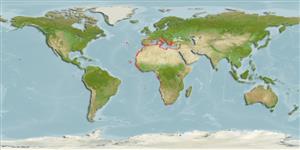Common names from other countries
Environment: milieu / climate zone / depth range / distribution range
Écologie
; profondeur 3 - 50 m (Ref. 417). Tropical; 46°N - 17°S, 18°W - 36°E
Eastern Atlantic and the Mediterranean: France south to Angola and east to Turkey.
Length at first maturity / Taille / Poids / Âge
Maturity: Lm ? range ? - ? cm Max length : 8.2 cm TL mâle / non sexé; (Ref. 104052)
Body length: 8 cm; Common body length: 3.0 to 6.0 cm (Ref. 417). Maximum depth from Ref. 79120. Intertidal (Ref. 122842), inshore (Ref. 105612) or along coasts (Ref. 78235). Found in an estuary (Ref. 122841). On sand (Refs. 417, 79120), mud (Refs. 417, 79383) and seagrass (Ref. 122842).
Life cycle and mating behavior
Maturité | Reproduction | Frai | Œufs | Fécondité | Larves
Members of the order Decapoda are mostly gonochoric. Mating behavior: Precopulatory courtship ritual is common (through olfactory and tactile cues); usually indirect sperm transfer.
Schneider, W. 1990. (Ref. 417)
Statut dans la liste rouge de l'IUCN (Ref. 130435)
statut CITES (Ref. 108899)
Not Evaluated
Not Evaluated
Utilisations par l'homme
Pêcheries: intérêt commercial mineur
| FishSource |
Outils
Plus d'informations
Taille/ÂgeCroissanceLongueur-poidsLongueur-longueurMorphologieLarvesAbondance
Sources Internet
Estimates based on models
Preferred temperature
(Ref.
115969): 16.5 - 27.4, mean 20.1 (based on 174 cells).
Vulnérabilité
Low vulnerability (10 of 100).
Catégorie de prix
Unknown.
